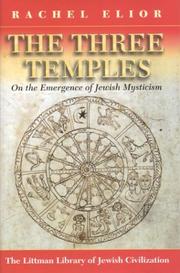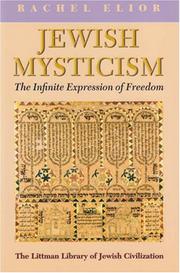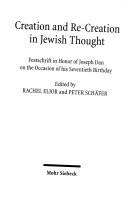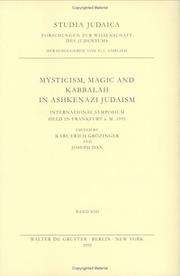| Listing 1 - 10 of 10 |
Sort by
|

ISBN: 0791410455 0791410463 Year: 1993 Publisher: Albany : State University of New York Press,
Abstract | Keywords | Export | Availability | Bookmark
 Loading...
Loading...Choose an application
- Reference Manager
- EndNote
- RefWorks (Direct export to RefWorks)
Habad --- Cabala --- Mysticism --- Kabbale --- Mysticisme --- Doctrines --- Influence --- Judaism --- History --- Judaïsme --- Histoire --- 141.33 --- 296*3 --- 296*3 Apocriefen --- Apocriefen --- 141.33 Filosofische mystiek --- Filosofische mystiek --- Chabad --- Lubavitch-Chabad --- Dark night of the soul --- Mystical theology --- Theology, Mystical --- Spiritual life --- Negative theology --- Hasidism --- Cabbala --- Jews --- Kábala --- Kabalah --- Kabbala --- Kabbalah --- Qabalah --- Jewish literature --- Magic --- Judaism&delete& --- Doctrines. --- Hasidim
Book
ISBN: 9789042936508 9042936509 Year: 2018 Volume: 31 Publisher: Leuven: Peeters,
Abstract | Keywords | Export | Availability | Bookmark
 Loading...
Loading...Choose an application
- Reference Manager
- EndNote
- RefWorks (Direct export to RefWorks)
This book is concerned with the exceptional history and unprecedented thought of Jacob Frank (1726-1791), a Messianic antinomistic Jewish-Moslem-Christian leader, active in the second half of the 18th Century in the Polish-Lithuanian Commonwealth, Othman empire, Moravia and Germany. Frank grew up in the Dönme circles in Salonika (Dönme was the Turkish name of the Moslem-Jews who were followers of the messianic leader Sabbatai Zevi (1626-1676), who was forced to become a Moslem. His followers decided to convert to Islam in 1683 in order to live separate Jewish messianic life). Frank defined himself in his mythical autobiography, known as The Words of the Lord as a chosen messianic Leader and as an anarchist visionary who decided to cross every border and to destroy every book, law and order. His anarchistic behavior as well as his broad social influence caused a persistent rabbinic persecution and excommunication that brought Jacob Frank and his thousands followers to undertake a mess conversion to Christianity in 1759-1760.

ISBN: 1874774668 9781904113331 9781909821040 1904113338 1909821047 Year: 2004 Publisher: Oxford ; Portland, Or. : Littman Library of Jewish Civilization,
Abstract | Keywords | Export | Availability | Bookmark
 Loading...
Loading...Choose an application
- Reference Manager
- EndNote
- RefWorks (Direct export to RefWorks)
In this ground-breaking study, Rachel Elior offers a comprehensive theory of the crystallization of the early stages of the mystical tradition in Judaism based on the numerous ancient scrolls and manuscripts published in the last few decades. Her wide-ranging research, scrupulously documented, enables her to demonstrate an uninterrupted line linking the priestly traditions of the Temple, the mystical liturgical literature found in the Qumran caves and associated directly and indirectly with the Merkavah tradition of around the second and first centuries BCE, and the mystical works of the second to fifth centuries CE known as Heikhalot literature. The key factor linking all these texts, according to Professor Elior's theory, is that many of those who wrote them were members of the priestly classes. Prevented from being able to perform the rituals of sacred service in the Temple as ordained in the biblical tradition, they channelled their religious impetus in other directions to create a new spiritual focus. The mystical tradition they developed centred first on a heavenly Chariot Throne known as the Merkavah, and later on heavenly sanctuaries known as Heikhalot. In this way the priestly class developed an alternative focus for spirituality, based on a supertemporal liturgical and ritual relationship with ministering angels in the supernal sanctuaries. This came to embrace an entire mystical world devoted to sustaining religious liturgical tradition and ritual memory in the absence of the Temple. This lyrical investigation of the origins and workings of this supernal world is sure to become a standard work in the study of early Jewish mysticism.
Hekhalot literature --- Merkava --- Mysticism --- Priests, Jewish --- 296*4 --- 296*4 Joodse mystiek --- Joodse mystiek --- Jews --- Dark night of the soul --- Mystical theology --- Theology, Mystical --- Spiritual life --- Negative theology --- Maʻaśeh merkavah (Jewish mysticism) --- Merkabah --- Merkavah --- Throne of God --- Heikhalot literature --- Cabala --- Judaism&delete& --- History --- Priests --- Judaism --- Hekhalot literature. --- Merkava. --- Priests, Jewish. --- History. --- Mysticisme --- Hékhalot --- Merkaba --- Prêtres juifs --- Judaïsme --- Histoire
Article
Abstract | Keywords | Export | Availability | Bookmark
 Loading...
Loading...Choose an application
- Reference Manager
- EndNote
- RefWorks (Direct export to RefWorks)
Book
ISBN: 9783111043913 Year: 2023 Publisher: Berlin Boston
Abstract | Keywords | Export | Availability | Bookmark
 Loading...
Loading...Choose an application
- Reference Manager
- EndNote
- RefWorks (Direct export to RefWorks)
The Unknown History of Jewish Women—On Learning and Illiteracy: On Slavery and Liberty is a comprehensive study on the history of Jewish women, which discusses their absence from the Jewish Hebrew library of the "People of the Book" and interprets their social condition in relation to their imposed ignorance and exclusion from public literacy.The book begins with a chapter on communal education for Jewish boys, which was compulsory and free of charge for the first ten years in all traditional Jewish communities. The discussion continues with the striking absence of any communal Jewish education for girls until the late nineteenth and early twentieth century, and the implications of this fact for twentieth-century immigration to Israel (1949-1959)The following chapters discuss the social, cultural and legal contexts of this reality of female illiteracy in the Jewish community—a community that placed a supreme value on male education. The discussion focuses on the patriarchal order and the postulations, rules, norms, sanctions and mythologies that, in antiquity and the Middle Ages, laid the religious foundations of this discriminatory reality.
Jewish women --- Jewish women --- Jewish women --- Education --- History. --- History. --- Social conditions. --- Jewish history. --- Jewish women. --- discriminatory laws. --- enforced illiteracy. --- patriarchal order.
Digital
ISBN: 9783111043913 9783111044521 9783111042770 Year: 2023 Publisher: Berlin ;; Boston De Gruyter
Abstract | Keywords | Export | Availability | Bookmark
 Loading...
Loading...Choose an application
- Reference Manager
- EndNote
- RefWorks (Direct export to RefWorks)
Book
ISBN: 3111042774 3111043916 Year: 2023 Publisher: Berlin/Boston Walter de Gruyter GmbH
Abstract | Keywords | Export | Availability | Bookmark
 Loading...
Loading...Choose an application
- Reference Manager
- EndNote
- RefWorks (Direct export to RefWorks)

ISBN: 1786949881 9781786949882 9781906764043 1906764042 1800340109 9781874774679 1874774676 Year: 2010 Publisher: Oxford Portland, Or. Littman Library of Jewish
Abstract | Keywords | Export | Availability | Bookmark
 Loading...
Loading...Choose an application
- Reference Manager
- EndNote
- RefWorks (Direct export to RefWorks)
A masterly investigation of the Jewish mystical phenomenon, from antiquity to the twentieth century, contextualized in the spiritual and historical circumstances in which it evolved.
Mysticism --- Judaism. --- 296*4 --- -Dark night of the soul --- Mystical theology --- Theology, Mystical --- Spiritual life --- Negative theology --- 296*4 Joodse mystiek --- Joodse mystiek --- Judaism --- -Joodse mystiek --- Mysticism - Judaism. --- -Judaism

ISBN: 3161487141 Year: 2005 Publisher: Tübingen : Mohr Siebeck,
Abstract | Keywords | Export | Availability | Bookmark
 Loading...
Loading...Choose an application
- Reference Manager
- EndNote
- RefWorks (Direct export to RefWorks)
Cabala --- Mysticism --- Kabbale --- Mysticisme --- History. --- Judaism --- Historiography --- Histoire --- Judaïsme --- Historiographie


ISBN: 9783110871753 9783110137446 Year: 2012 Publisher: Berlin ;; Boston De Gruyter
Abstract | Keywords | Export | Availability | Bookmark
 Loading...
Loading...Choose an application
- Reference Manager
- EndNote
- RefWorks (Direct export to RefWorks)
| Listing 1 - 10 of 10 |
Sort by
|

 Search
Search Feedback
Feedback About UniCat
About UniCat  Help
Help News
News